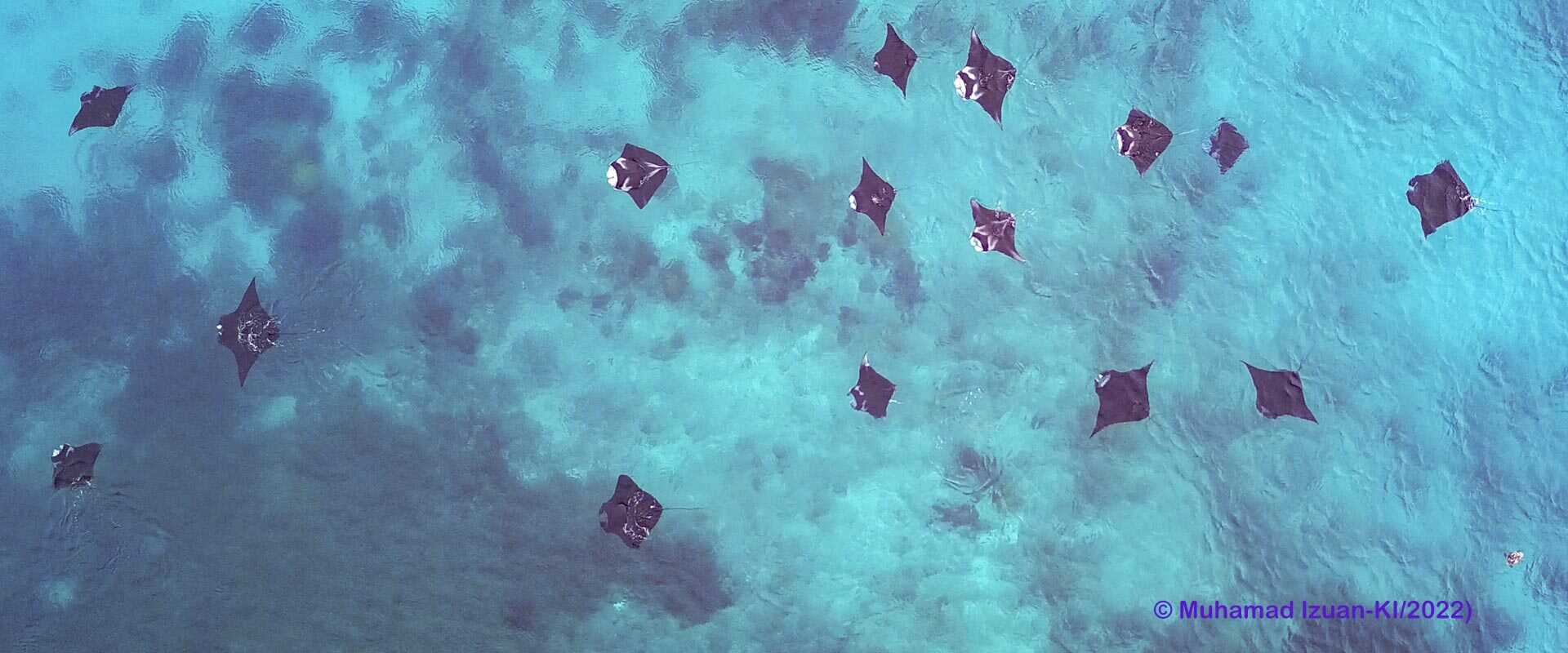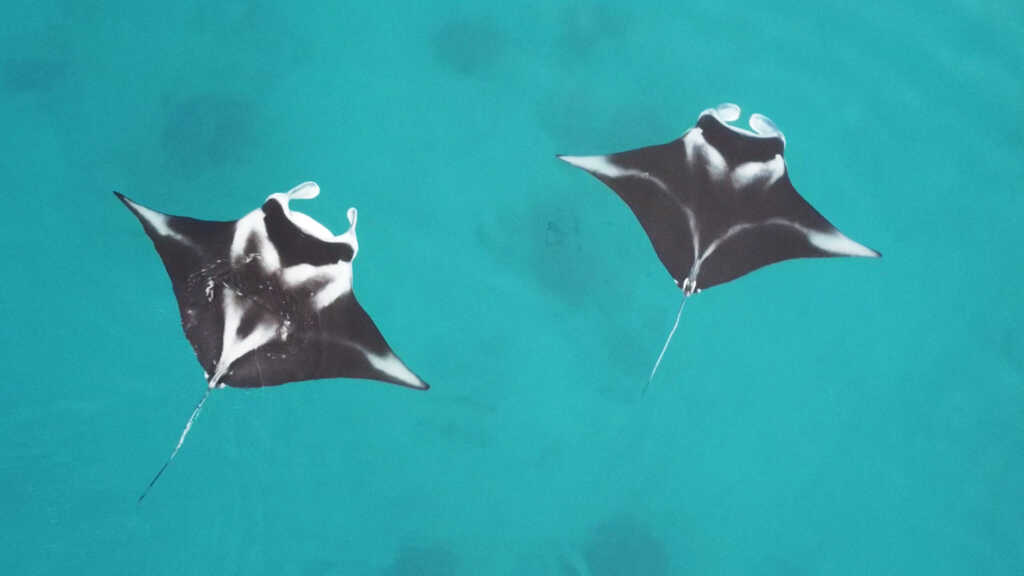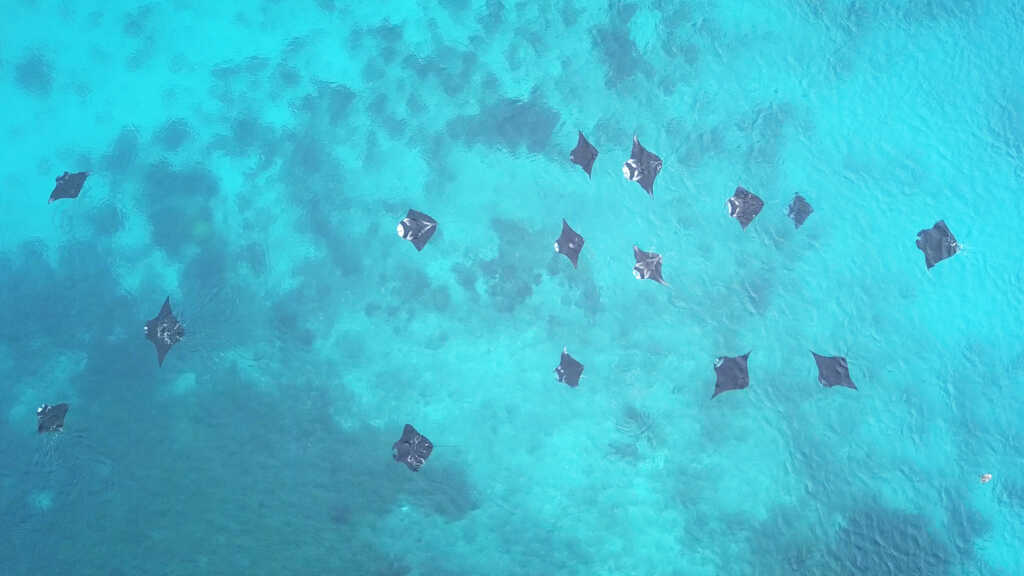Community And Park Authority Collaborates To Protect Manta Ray’s Nursery Ground In Fam Islands, written by Nikka Gunadharma*, reported by Rens Lewerissa**
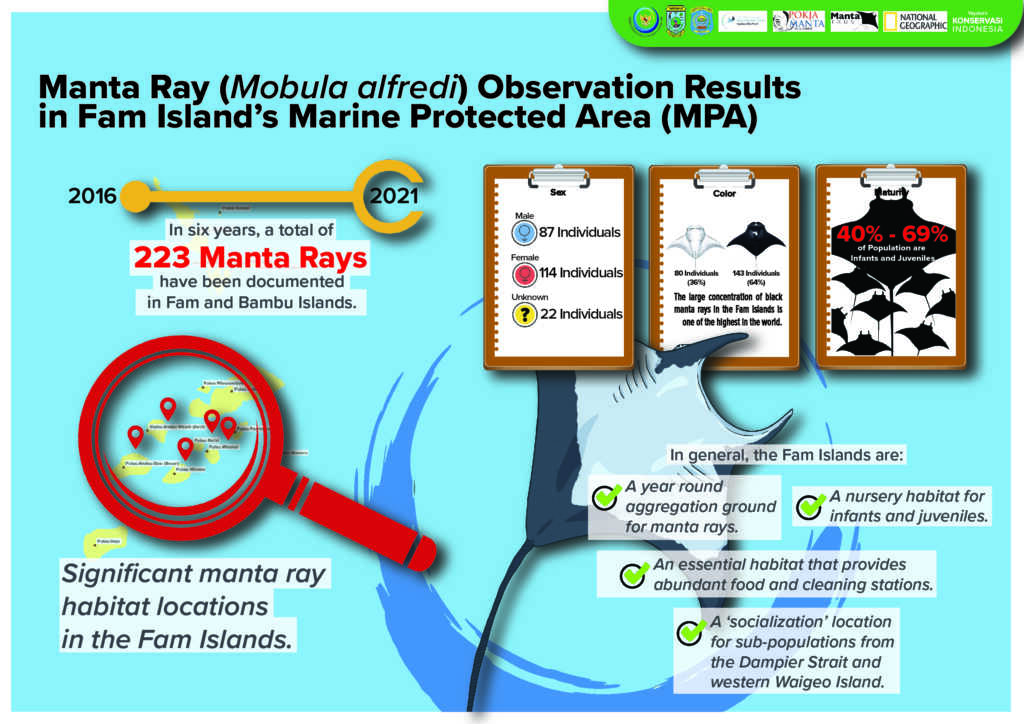
Results showing that the Fam Islands are an important habitat related to manta ray’s life cycle and population. (Infographic by: BLUD UPTD Pengelolaan KK di Perairan Kepulauan Raja Ampat/KI/2022)
Several key findings from an assessment on manta rays (Mobula alfredi) conducted in Fam Islands shows that the surrounding waters are important habitats for this protected fauna, for its food supply, and cleaning stations. Additionally the assessment strengthens the the fact that the Fam Islands are essential as a manta ray nursery and for juveniles.
From 2016 to 2021, the Manta’s Work Group*** under the leadership of Raja Ampat’s Marine Park Authority**** have assessed manta ray habitat and their population in the Fam Islands.
Fam Islands are one of the Marine Protected Areas (MPAs) managed under the marine park authority; an area that spans 369,000 hectares with intact coral reefs, and habitat for many species of reef fish, pelagics, several species of marine mammals, and of course: manta rays. This rather small archipelago is located 25 km (west) from the waters surrounding Arborek Island, which is one of the larger manta ray aggregation grounds in Raja Ampat. We only know so much, however, when it comes to the population and habitat of manta rays in Fam Islands.
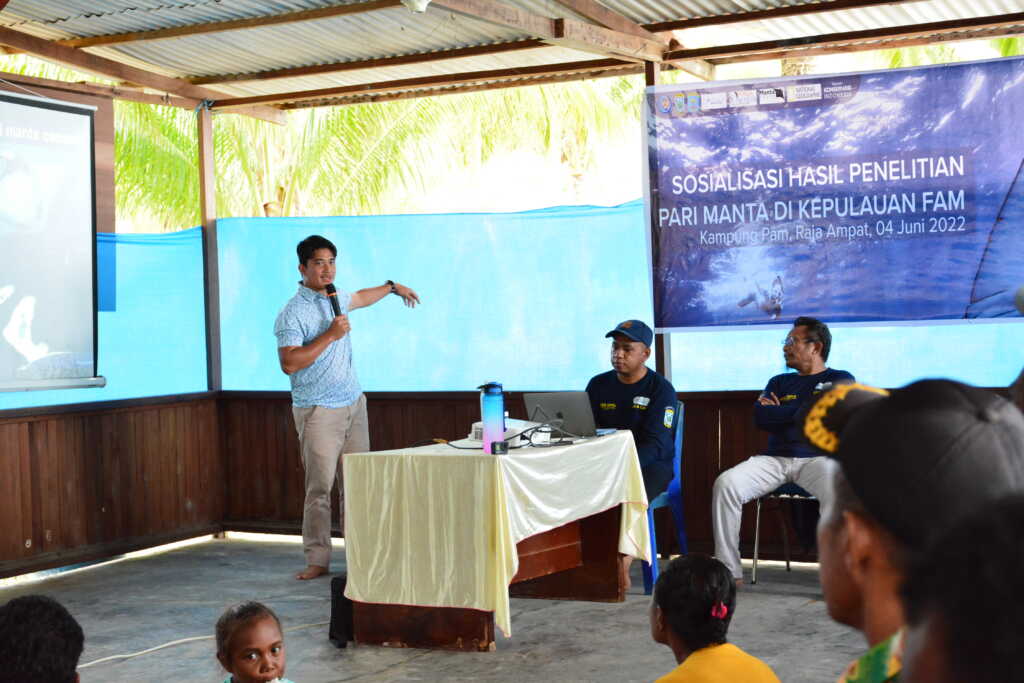
One of the researchers involved in the assessment, Muhamad Izuan, during a presentation in the socialization event in Fam Islands on the 4th of June, 2022. (Photo by: Rens Lewerissa-KI/2022)
The Fam Islands six year assessment to observe the population of manta rays and map their significant habitats was conducted via several methods of survey: surface, under water, and air. The manta ray population census was conducted through photographic documentation of the unique spot patterns on their bellies – similar to human finger prints. This method allows each individual to be identified.
Data and information generated from this assessment is expected to shed brighter light regarding the habitat and population of manta rays in Fam Islands, and the connectivity between the population there and populations in other areas found in Raja Ampat.
The assessment documented 223 manta rays, a ‘mere’ 13% of the total population of 1,682 identified in Raja Ampat, as of 2022. Of the 223 individuals, 40% to 69% were newborns and pups. This result strengthens the indication that the Fam Islands are a nursery ground for manta rays.
“Fam Islands met three criteria as nursery ground for manta rays. Firstly, the population is dominated by newborns and pups compared with other Raja Ampat populations, such as those in the Dampier Strait, which has been found to be primarily adults. Secondly, the newborns and pups roam Fam’s waters for a long periods of time, up to 28 months. Thirdly, once they become adults, the newborns and pups have been found to utilize Fam for years,” Edy Setyawan, the main researcher of the said assessment, explained.
Edy, who is currently studying for his doctorate in New Zealand, added, “These findings emphasize that Fam’s manta ray’s nursery ground is significant for the future sustainability of Raja Ampat’s manta population.”
At a socialization event in Fam Islands on June 4, 2022, Syafri, S.Pi., the Head of Raja Ampat’s Marine Park Authority, highlighted the survey as a strategic achievement, stating “Fam’s Manta ray nursery grounds are very sensitive, so it must be managed and utilized very carefully. It is important to protect manta rays but, at the same time, it is also important to ensure the benefits for the local communities in Fam Islands.”
Syafri then added, “We expect that the community and all the parties in Fam Islands will participate in efforts of sustainable protection, preservation, and utilization. Our next task is to convince them that protecting manta rays will provide additional benefits. Sustainably protecting manta rays and their habitat, prioritizes marine tourism utilization for the local communities.”
The socialization event was a collaboration with Konservasi Indonesia (KI)***** and was attended by 44 participants from three villages: Pam, Saukabu, and Saupapir. Several agreements, related to the area’s management, generated from the event are: Development of specific sub-zones to protect the nursery habitat and its population of manta ray newborns and juveniles. Prioritizing utilization of manta-based tourism for Fam’s local communities. And the implementation of a code of conduct and standard operating procedures that must be rigidly applied in the context of manta-based tourism in Fam Islands.
Regarding the adaptive management, Syafri emphasized, “Special protection through the establishment of a manta ray nursery zone, the application of strict rules in manta-based tourism, and a firm collaboration with the local communities and tourism actors are expected to become strategic steps for Fam Islands.”
The Secretary of Pam Village’s Government, who is also one of the homestay operators in Fam Islands, Yakobus Mambrasar said, “Together, the community should protect this animal so that it will be preserved, so that there will be an increase in the community’s economy, and tourists who wish to enjoy and swim (with the mantas) will also increase – but (we) must comply with the rules.”
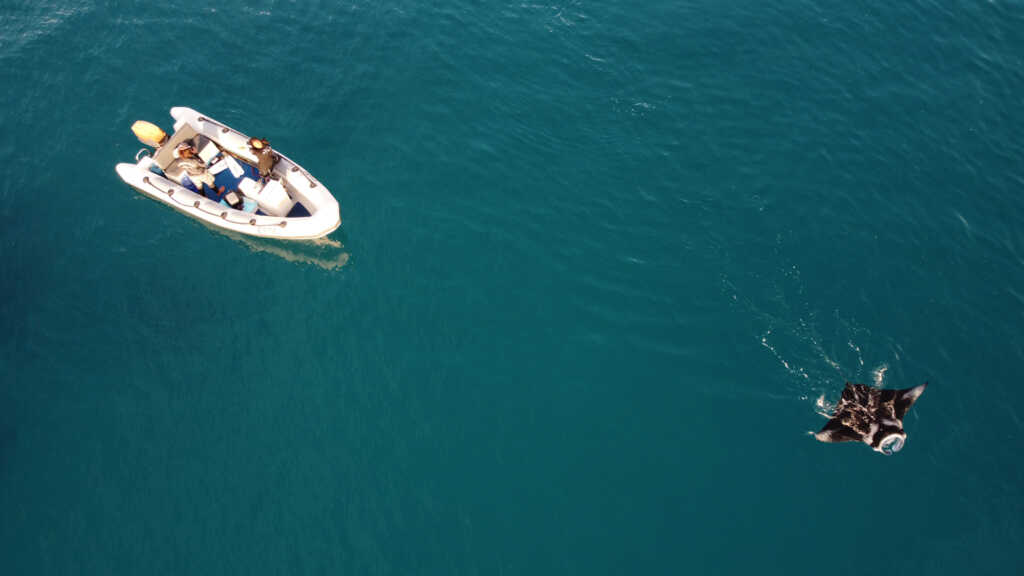
Boat survey: One of the methods utilized in order to collect data on manta ray in Fam Islands: . (Photo by: Muhamad Izuan-KI/2022)
Administrator’s Note: This event has was very well covered in the local media outlets. It is really positive news showing both local villagers and the UPTD BLUD making great plans to create manta nursery protection zones in the Fam MPA, thereby setting a global precedent!
If you read Bahasa and are interested here are links to the various media outlets coverage of the event:
https://teropongnews.com/zona-pembesaran-pari-manta-karang-di-kepulauan-fam-wajib-dilindungi/
https://m.rri.co.id/sorong/daerah/1506601/peniliti-temukan-titik-habitat-pari-manta-di-kepulauan-fam
https://matapapua.com/2022/06/23/ini-kawasan-pembesaran-pari-manta-di-kepulauan-fam-raja-ampat/
* Nikka Gunadharma is Raja Ampat Communication & Outreach Coordinator for Konservasi Indonesia.
** Rens Lewerissa is Raja Ampat Communications & Outreach Field Senior Officer for Konservasi Indonesia.
*** RAJA AMPAT’S MANTA RAY WORK GROUP
Raja Ampat’s Manta Ray Work Group is a collective entity consisting of West Papua’s Province Government – represented by Raja Ampat’s Marine Park Authority, Raja Ampat’s Regency Government, Manta Trust, Konservasi Indonesia, and other partners working in Raja Ampat that share common concerns regarding manta ray habitat management and population preservation through conservation efforts, and contributes in sustainable Marine Protected Areas’ (MPAs) management.
**** RAJA AMPAT’S MARINE PARK AUTHORITY
The official name for Raja Ampat’s Marine Park Authority is “Badan Layanan Umum Daerah Unit Pelaksana Teknis Daerah (BLUD UPTD) Pengelolaan Kawasan Konservasi (KK) di Perairan Kepulauan Raja Ampat.” It is a technical unit under West Papua’s Marine and Tourism Agency, which currently and officially, manages six Marine Protected Areas (MPAs) in Raja Ampat: Area I – Ayau-Asia Islands MPA; Area II – Mayalibit Bay MPA; Area III – Dampier Strait MPA; Area IV – Misool Islands MPA; Area V – Kofiau-Boo Islands MPA, and; Area VI – Fam Islands MPA. Raja Ampat’s Marine Park Authority also provides technical support for the West Waigeo Islands Marine Reserve (Wayag) MPA, which is managed by the central government. For further information, kindly visit www.kkprajampat.com (Bahasa Indonesia) or www.rajaampatmarinepark.com (English).
***** KONSERVASI INDONESIA
Konservasi Indonesia (KI) is a national foundation that aims to support the sustainable development and protection of critical ecosystems in Indonesia. We believe in the importance of multi-stakeholder partnerships across sectors and jurisdictions to support the preservation of critical ecosystems. We design and deliver innovative nature-based solutions to climate change, using a sustainable landscape–seascape approach to create lasting impacts for people and nature.
KI established strategic partnership with Conservation International (CI), following the closure of its programmatic operations in Indonesia. From three decades of work in Indonesia, CI adapted its strategy by partnering with KI. Our partnership with CI aims to increase the visibility of successes of our work for the international audiences, and to gain access towards global network as well. Kindly visit www.konservasi-id.org for further information.





































